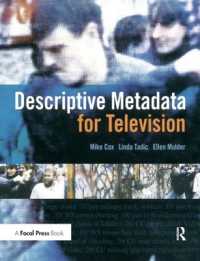- ホーム
- > 洋書
- > 英文書
- > Science / Mathematics
Full Description
This set includes the third edition of Computational Methods and GIS in Social Science and the accompanying lab manual. It integrates GIS, spatial analysis, and computational methods for solving real-world problems in various policy-relevant social science applications. Thoroughly updated, the third edition of the textbook, and its accompanying lab manual, showcase the best practices of spatial computational social science and include numerous new examples and case studies with step-by-step instructions in ArcGIS Pro, and open-source platform KNIME. KNIME supports visual programming and multiple scripting languages such as R, Python, and Java. It helps readers sharpen their GIS skills by applying GIS techniques in detecting spatiotemporal crime hot spots, measuring the accessibility of primary care physicians, forecasting the impact of hospital closures on the local community, or siting the best locations for business.
Features
Fully updated using the latest version of ArcGIS Pro and open-source platform KNIME
Includes many compelling examples and real-world case studies related to social science, urban planning, and public policy with clear step-by-step instructions
Provides newly automated programs for regionalization, functional region delineation, accessibility measures, maximal accessibility equality problem, and agent-based crime simulation
Includes 22 case studies from USA and China that parallel the methods developed in the textbook and enable readers to easily replicate and expand their work
Adds two new chapters on agent-based modeling and big data analytics
Provides support materials for downloading data and programs for implementing all case studies included in the book and the KNIME lab manual
This set is intended for upper-level undergraduate and graduate students taking courses in quantitative geography, spatial analysis, GIS applications in socioeconomic studies, GIS applications in business, location theory. Researchers in similar fields: geography, city and regional planning, sociology, criminology, public health, and public administration.
Contents
Textbook
Part I: GIS and Basic Spatial Analysis Tasks 1. Getting Started with ArcGIS: Data Management and Basic Spatial Analysis Tools 2. Measuring Distance and Travel Time and Analyzing Distance Decay Behavior 3. Spatial Smoothing and Spatial Interpolation Part II: Basic Computational Methods and Applications 4. Delineating Funcational Regions and Applications in Health Geography 5. GIS-bAsed Measures of Spatial Accessibility and Application in Examining Healthcare Disparity 6. Function Fittings by Regressions and Application in Analyzing Urban Density Patterns 7. Principal Compnents, Factor and Cluster Analyses and Application in Social Area Analysis 8. Spatial Statistics and Applications inCultural and Crime Geography 9. Regionalization Methods and Application in Analysis of Cancer Data Part III: Advanced Computational Methods and Applications 10. System of Linear Equations and Application of Garin-Lowry in Simulating Urban Population and Employment Patterns 11. Linear and Quadratic Programming and Applications in Examining Wasteful Commuting and Allocating Healthcare Providers 12. Monte Carlo Method and Applications in Urban Population and Traffic Simulations 13. Agent-Based Model and Application in Crime Simulation 14. Spatiotemporal Big Data Analytics and Application in Urban Studies
Lab Manual
1. Getting Started with KNIME and Its Geospatial Analytics Extension 2. Measuring Distance and Time and Analyzing Distance Decay Behavior 3. Spatial Smoothing and Spatial Interpolation 4. Delineating Functional Regions and Application in Health Geography 5. GIS-Based Measure of Spatial Accessibility and Application in Examining Healthcare Disparity 6. Function Fittings by Regressions and Application in Analyzing Urban Density Patterns 7. Principal Components, Factor Analysis and Cluster Analysis and Application in Social Area Analysis 8. Spatial Statistics and Applications 9. Regionalization Methods and Applications in Analysis of Cancer Data 10. System of Linear Equations and Application of Garin-Lowry Model in Simulating Urban Population and Employment Patterns 11. Linear and Quadratic Programming and Applications in Examining Wasteful Commuting and Allocating Healthcare Providers 12. Monte Carlo Method and Applications in Urban Population and Traffic Simulations 13. Agent-Based Model and Application in Crime Simulation 14. Spatiotemporal Big Data Analytics and Applications in Urban Studies








